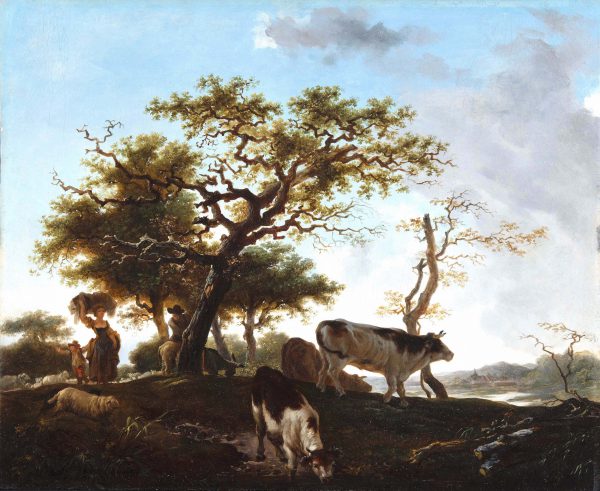Family of Shepherds in a family landscape, Ca. 1761-1765
Oil on panel., H. 0.38 m; W. 0.45 m
Provenance: Sale Dubois collection, 31 March 1784, no. 131 (621 livres, bought by Desmarest) : « A gauche, une rivière et des lointains ; sur le devant une jeune femme portant un paquet sur sa tête, accompagnée d’un petit garçon ; ils passent près d’un pâtre, monté sur un âne (…), auprès, deux bœufs, une génisse, sous des arbres à feuillage épais ».
Private Collection.
- Pierre de Nolhac, J.-H. Fragonard 1732-1806, 1906, p. 137 (cites Dubois 1784 sale).
- Georges Wildenstein, Les peintures de J. H. Fragonard, London, 1960, p. 231, no. 149 : “Paysage avec rivière, effet d’ombre” (Landscape with River. Shadow Effect), dated 1761-1765 (cites Dubois 1784 sale).
- Gabriele Mandel, Daniel Wildenstein, L’opera completa du Fragonard, Milan, 1972, no. 141 (cites Dubois 1784 sale).
- Jean-Pierre Cuzin, Jean-Honoré Fragonard. Vie et œuvre. Catalogue complet des peintures, Fribourg et Paris, 1987, p. 349, no. D 101 (as unknown whereabouts, cites Dubois 1784 sale).
Fragonard was a pupil of Jean Siméon Chardin and François Boucher. He obtained the Prix de Rome in 1752 and worked under Carle Vanloo in the Ecole royale des élèves protégés for three years. From 1756 to 1761 he studied at French Academy in Rome, at this time directed by Natoire who encouraged his pupils to work out of doors and draw landscapes. In Rome Fragonard became a close friend of Hubert Robert and the Abbé de Saint-Non. Fragonard and Robert worked a lot together in the country side and influenced each other profoundly in style.
On his return to Paris in 1761, Fragonard undertook a series of landscapes close in style to Dutch 17th century painting, revealing a direct influence of Dutch 17th century landscapes on the aesthetics of that time. Fragonard’s admiration for Jacob van Ruisdael, whose influence is evident in the present picture, was already brought to light. With great subtlety Fragonard shows condensed and sometimes threatening clouds that find an echo with the rough terrain and the silhouettes of trees. The artist adds rural figures, often heightened with lively red, and also animals at a watering place. Far from a simple imitation, Fragonard reinterprets the style of his predecessors according to his eighteenth century sensibility.
Whether or not Fragonard actually ever travelled to Holland remains uncertain. However, he could easily have studied Dutch 17th century landscapes in private collections in Paris. French collectors in the second half of the 18th century had a great passion for this genre and some of the finest examples could be found in their collections.



